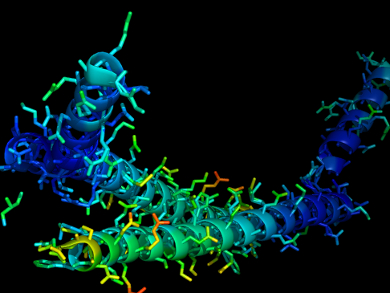Selenium is an essential trace nutrient for humans. It is contained in 25 different human selenoproteins in the form of the amino acid selenocysteine. The biological functions of many of these proteins are poorly understood. Since the production of selenoproteins by recombinant expression is inefficient, researchers usually study mutants in which selenocysteine is replaced by cysteine. These mutants have provided some insight; however, they are much less catalytically active and cannot replace the natural selenoproteins entirely in research.
Norman Metanis and colleagues, Hebrew University of Jerusalem, Israel, have performed the first total chemical synthesis of two human selenoproteins, namely selenoprotein M (SELM, pictured) and selenoprotein W (SELW).The team first prepared peptide fragments using, e.g., solid-phase peptide synthesis (SPPS), where peptides are built one amino acid at a time on a polymer support. The yields limit this approach to chains with a length of roughly 70 amino acids.
SELW, which contains 86 amino acid residues, was prepared from two such fragments using native chemical ligation (NCL). NCL is a reaction between two petides which involves the thiol group of an N-terminal cysteine attacking a thioester on a C-terminal amino acid in the presence of 4-mercaptophenylacetic acid (MPAA) as a catalyst. The longer SELM has 122 amino acid residues and was synthesized from four peptide fragments with three ligation reactions. The approach uses selenazolidine, a protected form of selenocysteine, to avoid unwanted reactions.
The method is suitable for the synthesis of selenoproteins on a milligram scale. According to the researchers, this should allow in-depth studies of these proteins.
- Accessing human selenoproteins through chemical protein synthesis,
L. Dery, P. Sai Reddy, S. Dery, R. Mousa, O. Ktorza, A. Talhami, N. Metanis,
Chem. Sci. 2017.
DOI: 10.1039/c6sc04123j




